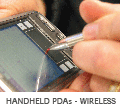For our Big-Eye project (a 3.1 Megapixel network camera for security and remote monitoring applications), we needed an efficient software algorithm for converting the Bayer-format data used by the image sensor to RGB data suitable for sending across the network / JPEG compression. A simple C algorithm was coded which did the job. However, it was very slow - about 1.7 seconds to convert a single frame. This was using GCC 4.1.1. The code was fairly well written, using word operations to move through the three lines of the image, two pixels at a time. It was not looking good. After spending a bit of time trying a few basic optimisation techniques, we decided to try the RealView compiler. This now supports most of the GNU options and it is fairly easy to build software using it. The result was pretty astounding. With no code changes, RealView produced an execution time of around 0.3 seconds! A bit of additional fiddling suggested that further improvements might be possible. The main difference seems to be that RealView makes much better use of registers, and thus needs a lot less load/store on the stack. This is probably a common feature of many image processing algorithms. If written with efficiency in mind, they will push the register set quite hard. Much assembler optimisation relies on using the register set more efficiently. But if the compiler can do it for you, so much the better. We could easily have spent a few days working on this part of the code, and with RealView it was just a re-compile. In the end we have moved all the code over to RealView and this is now the standard build environment.

Bayer Filtering with RealView versus GCCPosted in ARM Tools News on October 21, 2008 by Administrator |



